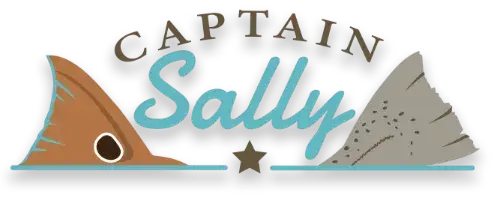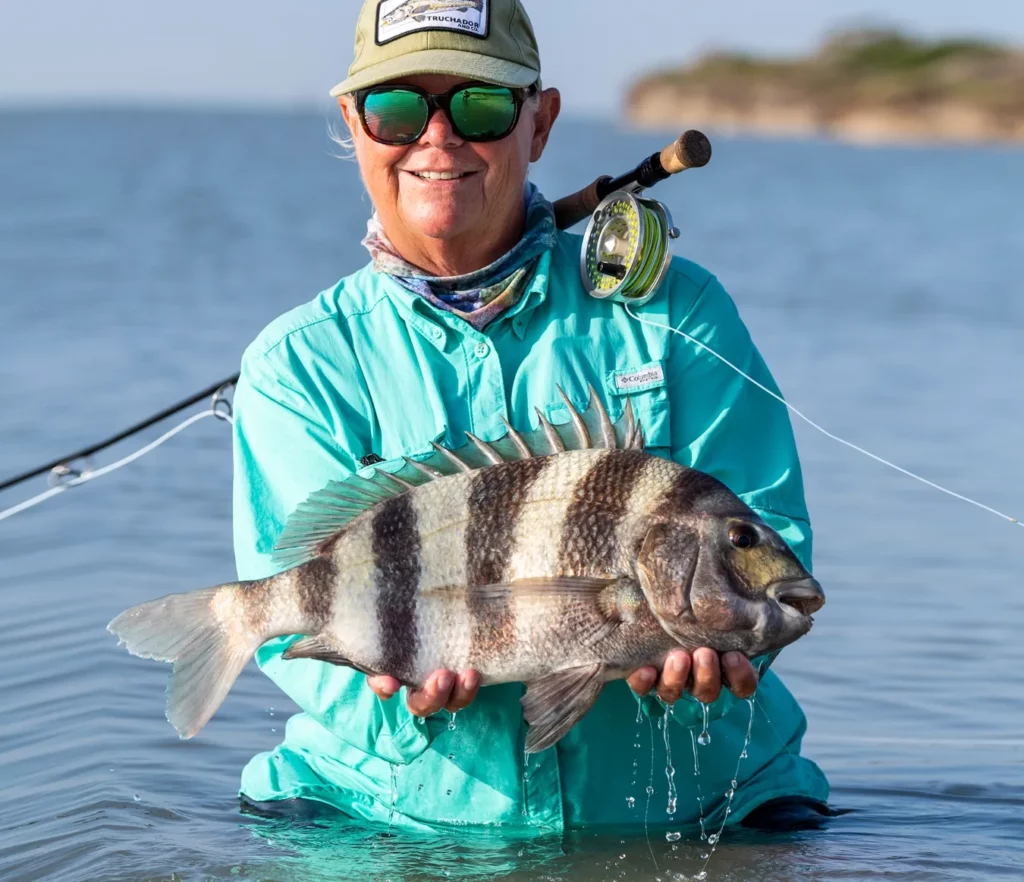How long have you been guiding? How did you get started in fly fishing?
I have been afull-time professional fishing and hunting guide for 21years on the Texas Coast. I hold a United States Coast Guard Near-Coastal Masters Captain’s license, which I obtained in 1998 in Rockport, Texas where I started my guiding career.
Growing upon the great lakes with an outdoorsman of a father who was in denial to the fact that I was a girl, i Fished and hunted all the time. Dad had a Cris Craft Cabin Cruiser on Lake frie where the family spent weekends fishing. He also had a camper on the back of a pickup and a boat on a trailer and spent all of his spare time with our family and me on the water, fishing. I even had a rod holder on my bike. We fished all summer long in ponds, rivers, streams and lakes. Bass, bluegill, crappy, walleye, perch and catfish where most of our targets, but in the winter, Dad took a couple of weeks off work to make our annual sojourn during Christmas to Florida, fishing down one coast and up the other. We fished everywhere we went and fished almost every style from cane pole to fly rods!
So with a background like that, it wasn’t surprising that I bought my first new fishing boat in Rockport, Texas in 1985 and set about learning the bay systems there. There wasn’t a woman to be found at the boat ramps at that time – so, since I was 25 years old, Igot a lot of commentary, all the time. Things like, “does your husband know you have his boat” or, “for a blonde, you can sure back up a boat trailer”!
Fishing was easy back then without a lot of boat pressure, especially in the secondary and tertiary bay systems there. All fishing was shallow and most of it was tidal, especially in the primary bays. I started out tossing a cast net for finger mullet, free lining them on the edges or in big potholes, waiting for redfish, trout or flounder to pick one up and run with it. That style of fishing was easy and fun. Pretty soon, some new good quality casting reels came on the market and took me to lure fishing. Moving into the seriousness of tossing plastics and top waters turned me into an “elitist” in the local fishing community.
I was a paralegal in the work world, but the last ten years of my career, 1turned into a contract paralegal because a real job interfered with my fishing. Lucky for me, l worked for some great attorneys who understood my addiction. At the end of my career as a paralegal,I asked my boss not to assign any more cases to me because I was going to go be a fishing guide. His comment was,”it’s about time!”
So, with my last big check, I bought a guide boat that 1could afford, qualified for my captains license and started this new career. 1had an instant clientele —families. There were only a few guides fishing out of Rockport at the time and to put it nicely, they were grumpy, crusty dudes. So, because of this, I started taking lots and lots of kids and families, fishing for mainly redfish in the flats of Rockport. A coupleof years of this and I started to think about other styles of fishing, including fly fishing.
During an annual Shallow Water Fishing Expo that I attended around 2002 in Houston, 1got to meet Stu Apte, Jose Wajebe, Lefty Kreh, Flip Pallot and one of the Godfathers of Texas Coastal Fly Fishing, Capt. Chuck Scates. Chuck’s slide show was so inspiring, and I got a chance to speak with him afterward. I asked him to teach me how to fly fish in Rockport. He said he’d “get back with me”.
One of my friends found a kayak for $50 at a garage sale and brought it over to me for my advice. He left it behind for me to try out. I put it in my guide boat and launched to explore a muddy back lake that wasn’t wadable. Paddling into the lake, birds were working over small groups of tailing redfish. This was fly fishing heaven. This was the future of my guide business. No one was using kayaks to explore the deep mangrove systems of the Rockport area, only two guides were fly fishing. This market was wide open, and it had my name written all over it. One day, a few months after the Shallow Water Fxpo, 1got a call from Capt. Chuck Scates. He would be leaving his post as the manager of the Redfish Lodge and going back out on his own as a fly-fishing guide again. He needed someone to teach him the back waters of Aransas Bay, which I knew like the back of my hand. So, we made a bargain. He would teach me how to fly fish and I would teach him the backwater secrets of Rockport. Perfect.
I became an Ocean Kayak dealer to outfit my kayak fly fishing business with limited money. Taking the “kayak and fly fishing show” on the road, I would speak at any and all CCA meetings, fishing clubs and seminars that I could to get the word out, dragging kayaks and accessories and speaking about the value of back lake kayaking fly fishing and teaching folks how to cast a fly rod.
Not yet able to afford a fancy poling skiff, I used my big boat to haul the kayaks out to the back lakes as a “mother ship”. Off-loading kayaks and paddling into the “back of the back” was an unbelievable adventure that my clients couldn’t get enough of. Fly fishing in the ankle-deep waters at pod after pod of tailing redfish was spectacular.
In2003, Maverick Boats gave me a brand new Maverick HPX-T, state of the art poling skiff. Poling a boat is one of the most fun skills I’ve ever learned, and I fell in love with the view and the excitement of seeing fish at that height. Adding this great boat to the mothership/kayak repertoire was genius. I could use the mobility of the skiff to find better concentrations offish and then when 1had a kayak trip,I would already know where the best concentrations offish were and could slowly target them, all day. Orvis put me on their pro staff as a fly guide at some point after that, working through Swan Point Landing and Dave Hayward. I stayed on the Maverick staff for about six years, then went to the New Water Boatworks Curlew and Ibis poling skiffs.
And, the rest is history with more history to be made!
What’s your main fishery like? Describe the kinds of fishing you do.
In 2009, 1was lucky enough to move from Rockport to Baffin Bay, a very unique bay about an hour and half south of Rockport. This bay is about 180 degrees away from where I came from and is known as a “hyper-saline, land-locked lagoon.
Talk about a life changing experience! No only did I marry the man of my dreams, Capt. Aubrey Black, who just happened to be known as the “guru of trophy trout” on Baffin Bay, but it took me one full year to bring enough of my Rockport clients to Baffin Bay to experience some of the most untouched fly fishing that exists on the Texas Coast!
Baffin Bay, being a “land-locked lagoon” has no tide. IYs too far from either Gulf inflow from the north or the south to make a difference. Water will eek in and eek out but at a snail’s pace which could take days, not hours. It’s a hyper-saline system that has no fresh water sources other than rainfall run-off, which ebbs and flows and why the area is known as the “Wild Horse Desert”.
Drought can befall the area and hang on for years, or, the area can be overloaded with rain. Baffin Bay is known for patterns that might last for years. It’s a big mystery and has been studied by scientists forever,who never agree on what’s really going on here. Such is the fickleness of Mother Nature!
As guides, however, the patterns are readable and can be followed, not matter what the system decides to do. Point of tact, Capt. Black said that in his 18 years as a guide on Baffin Bay, he had endured 4 brown tide events. Brown tides sometimes overtake the bay, making the deeper water look like a mud puddle. Funny thing about Baffin Bay though, the fish don’t leave. They adapt. Trout aren’t supposed to even live in this hyper-saline system, much less thrive. Baffin Bay is known as the bay that grows the biggest trout on the entire Texas Coast. Three of the last four State Records have come from Baffin Bay!
It’s a system in and of itself, and it takes a pro to really understand it. Wait, did I mention the rocks? Baffin Bay is one or two places in the world to host a serpulid worm whose casings have created vast rock systems in Baffin Bay. More like corral reefs, they are located everywhere in the bay and are home, like a coral reef, to all of the critters that big predators eat. The rocks are deep and shallow. Keying on these rock piles at certain times of the year can be super productive. Some of the rock piles, even in the middle of the bay, can be wade fished. Wade fishing is one of the primary ways to fish this trophy fishery.
Through wet years, drought, brown tide, crystal clear water, lots of grass, no grass, you name the condition of the bay system, one thing we know for sure… all big fish are shallow under all conditions. from ankle deep to waist deep, all big fish lurk around the vast quantities of bait. Bait, just like the fish, are plentiful and big on Baffin Bay and love the shorelines and the rock systems. Because everything has adapted and thrives in this unique system, all of it just keeps growing whether prey or predator and in mass quantity.
Baffin Bay is known for growing the largest Speckled Trout on the Texas Coast. Specifically, because of the reasons mentioned above, but other factors include very little boat and fishing pressure. Because of the remoteness of the bay, and the mysterious rock systems, anglers really have to want to fish Baffin. The bay also runs east and west, into the land mass, unlike the rest of the bays on the Texas Coast. The entire north side of Baffin Bay is the legendary King Ranch and the entire south side of the Bay is the Kenedy Ranch. No water towers, power Hnes, houses, condos, nothing. This will not change in my life time or maybe many others, so the vast remoteness of the bay is protected from development.
One small strip of humanity exists on the very west end which is the location of our lodge, Baffin Bay Rod and Gun. Of all of the Texas Coastal Fisheries, Baffin Bay is the most unique and specific.
Because the fishery is known for Trophy trout, Baffin Bay Rod and Gun specializes in targeting them very successfully. The best way to catch big trout is by wade fishing in shallow water throwing lures with conventional tackle or fly fishing (either blind casting or sight casting) with floating line or sinking tips. Trophy trout can be caught all year-round, but Trophy trout season begins when the water temperatures begin to drop, usually in the end of October or early November. The cycles of water temperatures tell big fish that winter is coming and the feeding up for the winter begins in earnest. As the months go on, the fish get bigger and bigger, with the biggest fish being caught just prior to and during the spawn, which begins when the water temperatures rise to around 75 and stays there. This could happen in late March, late April or early May. This is when the trout are the heaviest and most aggressive. New moon fishing is much more productive than full moon. At Baffin Bay Rod and Gun,we are poised to catch that new State Record Trophy Trout and it’s the goal, every year!
As the summer approaches, the focus shifts to shallow water sight casting to redfish and black drum. This style of fishing begins to take up more and more of our time because it’s just so much fun. Early mornings are spent tossing top water lures or big poppers up toward the bank, looking for good feeding trout As soon as the sun gets to the right height in the sky (10:00 am or so), we change gears and goup super skinny with fly rods and clousers or crabs or light tackle with super light and small jig heads (Black’s Magic, 1/32oz, our own design). Lightly walking along the grass edges, sand pockets and sandy banks, looking for lurking and feeding predators in ankle deep water.
The fun summer pattern stays with us for a long time, almost all the way through the fall, and then, the cycle begins all over again! We all use super shallow water boats with large motors to get everyone to the fishing, fast and comfortable. Some of our guides use poling skiffs as well. Because Baffin Bay is a really big bay systems with long, sandy shorelines with very few back lakes are marshes, it’s unlike any other bay on the Texas Coast. We at Baffin Bay Rod and Gun have mastered the mysterious Baffin Bay and look forward to showing everyone the absolute desolate beauty of the “Last Best Place on the Texas Coast”!
What’s the one thing that your clients need to work on?
Here on Baffin Bay, the most important thing about being a successful sight caster is seeing the fish (and more importantly, seeing the fish before they see you). Understanding the shapes, colors, movements and high probability locations of the predator fish under the water is not as easy for someone who doesn’t do it every day. That kind of focus is easy for a guide because we look at fish every day. Imparting that kind of knowledge to clients is the most important thing to start getting shots at fish.
Clients should start by having the right pair of sunglasses and a hat with a dark under brim. Sunglasses in high-contrast colors such as brown, amber or vermillion are essential. All other colors are a detriment to seeing fish on the bay system.
Short, accurate casts are more important here than big long shots. See the fish fast, get the fly to the fish, catch the fish! Fancy casts are nice but getting the job done is better and seeing the fish as soon as possible is the best way to catch a bunch on the fly!
Favorite winter species to target?
Winter fishing on Baffin Bay equal trophy trout. Atrophy trout on this bay is over 30″. Eight to ten- pound fish are regularly caught during the entire winter and into the early spring. The biggest, heaviest fish will be caught closer to the spawn which happens when the water temperatures rise to 75 degrees and stays there. The trout have been feeding up all winter to survive and then also feeding up for the spawn. An eight-pound trout caught in December could balloon up to a ten or even an eleven pounder inMarch. However,Baffin is the kind of bay that can offer us a new Texas State Record on any given day witch is currently nearly 14 pounds!
Another great winter species to target are the many gigantic redfish that live in the system. Redfish in other bay systems move out to the gulf and stay there when they grow to be 29″ and up. In Baffin Bay, because the bay is so far away from any gulf outlets, the redfish don’t leave to spawn, they get the job done rigfit there! So, because of this, tfiere are herds of these gigantic redfish in the 50″ class that are around 50 to 60 years old I They feed deep and shallow, but when they are shallow, half of their bodies are out of the water. These are always prime for a new tippet class record in the IGFA World Record book! !f they are up shallow, they are usually eating, so tossing just about anything in from of them will result in a strike! Hold on.
Top Winter Flies:
Believe it or not, my top winter flies are also my top summer flies, with a few slight changes! White clousers tied with arctic fox fur with red gills and bead-chain eyes (Foxy Clouser) tied on a k4 hook is a fty that performs miracles here on Baffin Bay. The other miracle fly here is a white crab, bead-chain eyes and a #4 hook. The tail on this crab is tied with arctic fox fur as well. Arctic fox fur really undulates in the water, giving the fly lots of free-swimming life. In the winter, I’ll toss of few of these same flies tied with mini-barbell eyes and lots more material giving it a bigger presence in the system. Since fish like to eat bigger in the winter and there isn’t much small food in the system, throwing bigger flies will catch more fish. Now, fishing for trophy trout calls for something even bigger. Trout can eat 2/3′” of their body length. So when they do eat, they want more “bang for their buck”. Again, a big white streamer
or something that looks like a five to six inch mullet. Dave Hayward at the Swan Point Landing Store in Rockport ties some of these big whopper trout flies. They are white Sea Ducers, and 1just call them “baby hamsters”, but they catch big trout!



